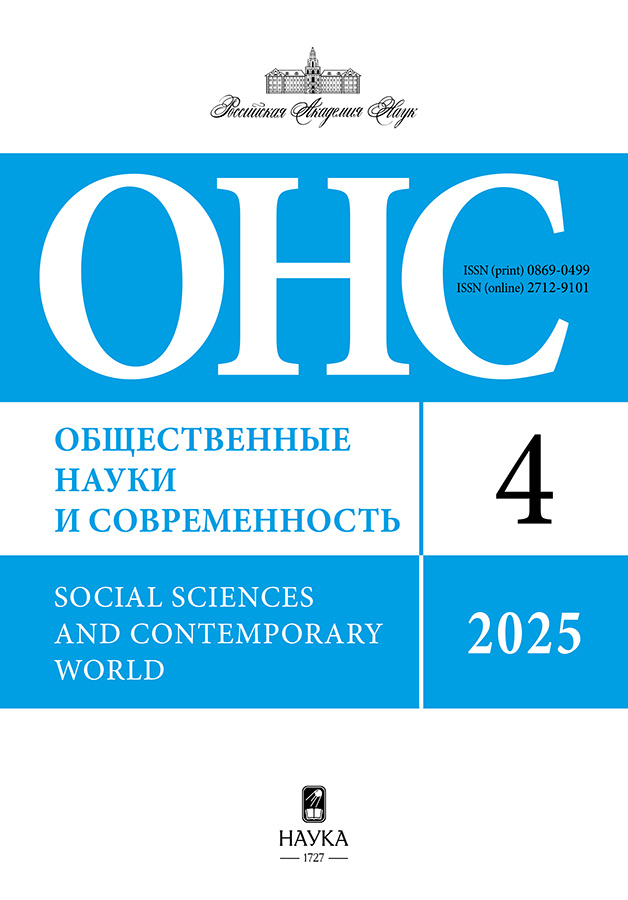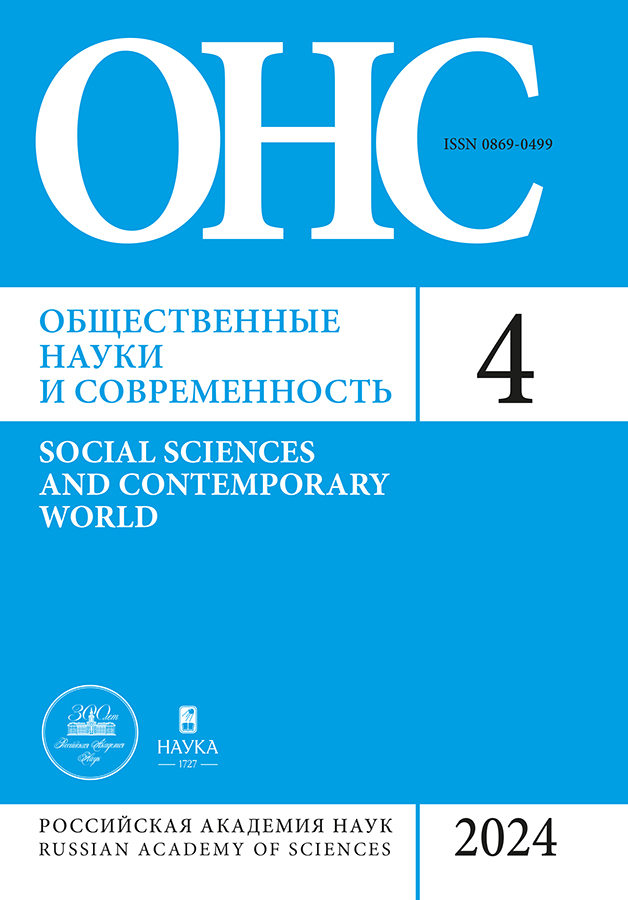Проблема «сжатия» российского освоенного пространства и пути ее решения
- Авторы: Дружинин А.Г.1, Кузнецова О.В.2
-
Учреждения:
- Северо-Кавказский НИИ экономических и социальных проблем Южного федерального университета
- Институт народнохозяйственного прогнозирования РАН
- Выпуск: № 4 (2024)
- Страницы: 114-127
- Раздел: Точка зрения
- URL: https://clinpractice.ru/0869-0499/article/view/676218
- DOI: https://doi.org/10.31857/S0869049924040094
- EDN: https://elibrary.ru/ZGSJDO
- ID: 676218
Цитировать
Полный текст
Аннотация
Постсоветские социально-экономические трансформации в сочетании с трендами депопуляции вывели на авансцену национальной повестки проблему «сжатия» (селитебного и хозяйственного) освоенного российского пространства. В условиях перехода к новому миропорядку этот вопрос требует системного осмысления и учета, в том числе в рамках федерального стратегирования пространственного развития. Представлен анализ ретроспективы, идентифицированы присущие современной России основные факторы, тенденции и ареалы «сжатия» освоенного пространства. Продемонстрированы возможности и обоснованы конкретные направления купирования данного процесса, минимизации его негатива. Показано, что социально-экономическое «опустынивание» обширных периферийных территорий сопряжено с хозяйственно-технологическими, демографическими и социокультурными изменениями. Осмыслен, в том числе критически, советский опыт реконструкции сети сельских населенных пунктов в Нечерноземье, обсуждены его уроки применительно к современным реалиям. Сформулированы предложения по учету феномена «сжатия» освоенного пространства в новой Стратегии пространственного развития России. В частности, предложено сместить мониторинговые и регулятивные акценты на муниципальный уровень.
Полный текст
Об авторах
Александр Георгиевич Дружинин
Северо-Кавказский НИИ экономических и социальных проблем Южного федерального университета
Автор, ответственный за переписку.
Email: alexdru9@mail.ru
ORCID iD: 0000-0002-1642-6335
доктор географических наук, профессор, директор
Россия, Ростов-на-ДонуОльга Владимировна Кузнецова
Институт народнохозяйственного прогнозирования РАН
Email: kouznetsova_olga@mail.ru
ORCID iD: 0000-0003-4341-0934
доктор экономических наук, профессор, главный научный сотрудник
Россия, МоскваСписок литературы
- Аверкиева К.В. (2012) Инновации в сельском хозяйстве Нечерноземной зоны России как ответ на «сжатие пространства» // Известия РАН. Серия географическая. № 4. С. 20–31.
- Агафонов Н.Т., Лавров С.Б., Хорев Б.С. (1982) О некоторых ошибочных концепциях в урбанистике // Известия Всесоюзного географического общества. Вып. 6. С. 533–538.
- Алексеев А.И. (1988) Сельское расселение: концепции и реальность // Вопросы географии. Сб. 132. С. 144–182.
- Безруков Л.А. (2006) Сибирские ТПК на рубеже веков: делимитация, значимость, эффективность // В: Пространственная организация хозяйства: ТПК или кластеры? М.: ИГРАН, МАРС. С. 120–131.
- Бочарников В.Н. (2016) Геопространство «дикой природы» // Социально-экономическая география. Вестник Ассоциации российских географов-обществоведов. № 5. С. 165–175.
- Бухвальд Е.М., Кольчугина А.В. (2019) Стратегия пространственного развития и приоритеты национальной безопасности Российской Федерации // Экономика региона. Т. 15. Вып. 3. С. 631–643. https://doi.org/10.17059/2019-3-1
- Города запада России и Великая Отечественная война (2021) Смоленск: Смоленский государственный университет. 408 с.
- Дегтярев А.Я. (1980) Русская деревня в XV-XVII веках: Очерки истории сельского расселения. Л.: Изд-во ЛГУ. 176 с.
- Карачурина Л.Б., Мкртчан Н.В. (2013) Различия в динамике численности населения по поселениям разного размера и статуса // Вопросы географии. Сб. 135. С. 82–107.
- Ковалёв С.А. (1962) География сельского расселения в перспективе // Вопросы географии. Вып. 57. С. 89–120.
- Ковалёв С.А. (2013) Развитие сельского расселения в Советском Союзе // Вопросы географии. Вып. 135. С. 126–146.
- Коломак Е.А., Крюков В.А., Мельникова Л.В., Селиверстов В.Е., Суслов В.И., Суслов Н.И. (2018) Стратегия пространственного развития России: ожидания и реалии // Регион: экономика и социология. № 2. С. 264–287. https://doi.org/10.15372/REG20180212
- Колосовский Н.Н. (1932) Будущее Урало-Кузнецкого комбината. М.–Л.: Соцэкгиз. 136 с.
- Королёв А.Ю. (2022) Ареалы ненаселенности: структура и функциональное зонирование на примере Северного Урала // Географический вестник. № 2. С. 153–165. https://doi.org/10.17072/2079-7877-2022-2-153-165
- Кузнецова О.В. (2022) Развитие муниципальной проблематики в государственной пространственной политике России // Региональные исследования. № 2. С. 16–24. https://doi.org/10.5922/1994-5280-2022-2-2
- Лаженцев В.Н. (2021) Арктика и Север в контексте пространственного развития России // Экономика региона. Т. 17. Вып. 3. С. 737–754. https://doi.org/10.17059/ekon.reg.20213-2
- Лаппо Г.М. (2019) Разнообразие городов как фактор успешного пространственного развития России // Известия РАН. Серия географическая. № 4. С. 3–23. https://doi.org/10.31857/S2587-5566201943-23
- Лексин В.Н. (2021) Системные основания и последствия территориально опосредованной депопуляции // Регион: Экономика и Социология. № 2. С. 101–134. https://doi.org/10.15372/REG20210205
- Лола А.М. (2005) Основы градоведения и теории города (в российской интерпретации). М.: КомКнига. 324 с.
- Маркварт Э., Киселева Н.Н., Соснин Д.П. (2022) Система опорных населенных пунктов как механизм управления пространственным развитием: теоретические и практические аспекты // Власть. Т. 30. № 2. С. 95–111. https://doi.org/10.31171/vlast.v30i2.8939
- Нефедова Т.Г. (2010) Сжатие внегородского освоенного пространства России – реальность, а не иллюзия // В: Сжатие социально-экономического пространства: новое в теории регионального развития и практике его государственного регулирования. М.: Эслан. С. 128–144.
- Нефедова Т.Г., Трейвиш А.И. (2020) Поляризация и сжатие освоенных пространств в Центре России: тренды, проблемы, возможные решения // Демографическое обозрение. Том 7. № 2. С. 31–53. https://doi.org/10.17323/demreview.v7i2.11138
- Пивоваров Ю.Л. (1997) Сжатие интенсивно используемого пространства: концепция макрорегионального развития России // Известия РАН. Серия географическая. № 5. С. 114–124.
- Смирнов И.П., Смирнова А.А., Ткаченко А.А. (2020) Итоги проведения политики сселения малых деревень в Нечерноземье (на примере Тверской области) // Вестник Московского университета. Серия 5: География. № 4. С. 105–115.
- Сущий С.Я., Дружинин А.Г. (1994) Очерки географии русской культуры. Ростов-на-Дону: изд-во СКНЦВШ. 576 с.
- Трейвиш А.И. (2010) «Сжатие пространства»: трактовки и модели // В: Сжатие социально-экономического пространства: новое в теории регионального развития и практике его государственного регулирования. М.: Эслан. С. 16-31.
- Трейвиш А.И. (2009) Город, район, страна и мир. Развитие России глазами страноведа. М.: Новый хронограф. 372 с.
- Ускова Т.В., Патракова С.С. (2021) Развитие сельских территорий в условиях пространственного сжатия северного региона // Экономические и социальные перемены: факты, тенденции, прогноз. Т. 14. № 5. С. 34–52. https://doi.org/10.15838/esc.2021.5.77.2
- Харитонов А.В., Бондарев Н.С., Бондарева Г.С. (2023) Формирование механизма устойчивого развития сельских территорий региона на основе сельских агломераций. Томск: Изд-во Том. ун-та. 362 с.
- Хорев Б.С. (1988) Реконструкция сельского расселения: новый этап научно-технической политики // Вопросы географии. Вып. 132. С. 34–52.
Дополнительные файлы











